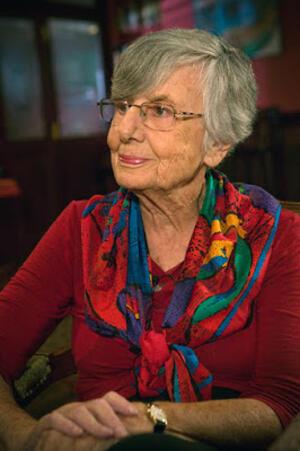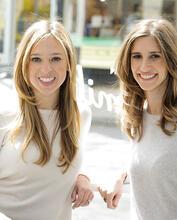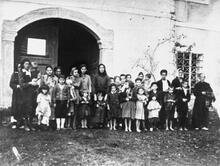Ruth Bondy
Author, journalist, and translator Ruth Bondy was born in Prague to a large Zionist family, the majority of whose members perished in the Holocaust. Bondy survived Theresienstadt and Auschwitz-Birkenau and arrived in Israel in late 1948. She began by teaching Hebrew and soon became a journalist, contributing to the genre of “color pieces” with a human-interest angle. Her journalistic skills and the unique interview style led her to begin writing biographies as well. She wrote over twenty works, mostly biographies, and even one cookbook. As a translator of Czech literature, she also made a unique contributiong to the cultural enrichment of Israelis. Although she did not wish to be identified as a “Holocaust Survivor,” she was involved in activities to preserve the history of Czechoslovakia’s Jews.
Early Life and Education
Ruth Bondy was an author, a journalist, and a gifted translator from Czech to Hebrew. She was born in Prague, to a large Jewish-Zionist family, the majority of whose members perished in the Holocaust. Her father Yoseph, a bank executive, died in Dachau on February 5, 1945. Her mother Frantzi died of blood poisoning in Theresienstadt in November 1942. “Four of us came back from the Holocaust: Grandma Herman, my cousin Otta, my sister Dita, and me. Twenty-five were wiped out. … Statistically speaking—a lucky family. After all, someone survived to tell its story” (Whole Fragments, 29).
Bondy was born, raised, and educated in the democratic Czechoslovakia of the post-World War I years. Like many of her contemporaries, she received a broad education in a range of subjects, including journalism and the rich body of Czech literature. She led a full social life, with many non-Jewish friends. Like most young people with Zionist leanings, she belonged to a youth group: Noar Ziyyoni Lohem (Zionist Fighting Youth), known by the acronym of NeZaH (Eternity). Along with numerous members of the Zionist youth groups in Czechoslovakia, Bondy was sent for hakhsharah (agricultural training) in preparation for her future Lit. "ascent." A "calling up" to the Torah during its reading in the synagogue.aliyah to pre-State Palestine.
The Holocaust
However, the German entry into Prague on March 15, 1939, and the new reality confronting the Jews of Czechoslovakia put an end to the plans of the Zionist movements. The members answered the call of Jacob Edelstein (1903–1944), a Zionist leader who directed the Palestine Office in Prague. Bondy, like many of her comrades, was mobilized to run the educational and social activities that had now become the responsibility of the young members of the Zionist youth movements, recently united under an umbrella organization, He-Haluz.
In October 1941 the Germans decided to set up a ghetto for the Jews of Czechoslovakia in the garrison town of Terezin. Construction of the ghetto (henceforth known by its German name of Theresienstadt) commenced one month later. It was the young members of He-Haluz who prepared the ghetto for the impending arrival of the Jews. Among the first to reach there was Bondy’s then-boyfriend and lifelong friend, Honze. When she arrived at the ghetto, Bondy was nineteen years old.
As a member of a Zionist youth group, Bondy worked in a vegetable garden along with many of her comrades and was also involved in the unique and extensive educational activities that developed in the Theresienstadt ghetto. Most of her family members also came to the ghetto and several of them perished there.
In December 1943 Bondy was included in a transport to the Auschwitz-Birkenau death camp together with many of her comrades. In a special section of Birkenau (B2b) a separate camp was set up for Jews from the Theresienstadt ghetto. Bondy and her comrades were sent to this camp, where men, women, and children lived together, no selektions took place, and the prisoners’ heads were not shaven; however, prisoner numbers were still tattooed into their arms. Bondy was assigned the number 72430. After she immigrated to Israel a doctor removed the number from her arm at her request. “Here in Israel, the Jews also asked me: How is it that you survived? What did you have to do to stay alive? And in their eyes, a flicker of suspicion: Kapo? Whore? This was one of the reasons why I decided, in my second year in Israel, to remove the Auschwitz inmate number from my arm” (Whole Fragments, 44).
Aliyah to Israel and Journalistic Career
In July 1944, roughly one month after the Czech family camp was liquidated, Bondy was transferred with a group of women prisoners to Hamburg, Germany. A short time later, following her miraculous recovery from typhus, came the day of liberation. At the age of twenty-two Bondy returned to Prague, alone. There, she volunteered for a fighting unit made up of young Jews who wished to immigrate to Palestine and help fight in the War of Independence. In August 1948 she took part in a military training camp, arriving at the port of Haifa on December 31 of that year.
One of her first assignments was teaching Hebrew. Within a relatively short time she began writing for a Czech periodical. But there was still one goal that eluded her: to write solely in Hebrew, a goal motivated by “Zionism, naiveté, ignorance, gall, determination—each of them alone and all of them together.” (Whole Fragments, 93).
Bondy became a journalist for the Davar newspaper, initially as Haifa correspondent for Omer, a Davar newspaper in simple Hebrew for new immigrants. Beginning in 1953 she became a correspondent for Devar ha-Shavua and Omer in Tel Aviv. As a reporter for Davar, Bondy made an important contribution to the journalistic genre of “color pieces” with a human-interest angle, which describe people and places and reveal the personal side of anonymous individuals and public figures alike.
Becoming a Biographer
Her journalistic skills and the unique style of the interviews she conducted led to a critical development in her literary writing, namely the composition of biographies. “Biography,” she maintained, “is actually a blending of life stories, that of the writer and that of the subject” (Shevarim Shelemim, 163). The protagonist of her first biographical work was Enzo Sereni, the oldest of the Jewish parachutists from Palestine who were dropped behind enemy lines in World War II (Ha-Shaliah: The Life and Death of Enzo Sereni, 1971). This remarkable work was awarded the Yizhak Sadeh Prize in 1974. In Shevarim Shelemim she relates that this biography of a parachutist who was killed in a concentration camp led to her choice of a subject from the Holocaust period for her next work—Jacob Edelstein (1903–1944), chairman of the Ältestenrat (Council of Elders) in the Terezin Ghetto. Edelstein Against Time (1981), the first work in which she dealt directly with the Holocaust, was also the first Hebrew work to bring the story of this ghetto to the attention of the Israeli public. She subsequently wrote many further books and articles on Terezin and also translated into Hebrew all the issues of Kamarad, a paper for young people that was published in Czech in one of the ghetto’s children’s houses.
Bondy’s flowing style of writing and rich Hebrew were a welcome addition to the Hebrew bookshelf. Bondy authored over twenty works, most of them biographies, and even one cookbook. As a translator of Czech literature, she also made a unique contribution to the cultural enrichment of Israelis. Among her translations is The Good Soldier Schweik, the masterpiece by Jaroslav Hašek (1883–1923). This work held special significance, since she and her fellow inmates in the Theresienstadt ghetto had turned to Schweik to keep up their spirits (“We’ll meet at six after the war” is a famous quotation from the work).
Preserving History
Although Bondy did not wish to be identified as a “Holocaust survivor,” she wa involved in activities to preserve the history of Czechoslovakia’s Jews through Beit Terezin, the center for the commemoration of Czech Jewry at Kibbutz Givat Hayyim-Ihud. She also participated in international conferences in Israel and abroad.
In 1981 she became a member of Sovlanut (Tolerance), a non-partisan movement for the prevention of violence that sought to educate Israelis on the importance of tolerance. The movement worked primarily with politicians, with the aim of moderating the aggressive nature of the election campaign. Following the assassination of Prime Minister Yitzhak Rabin in November 1995, Bondy distanced herself from the movement out of a sense of disappointment: “I went into internal exile.” (Whole Fragments, 214).
From her marriage to the journalist Rafael Bashan in 1954, Ruth Bondy had one daughter, Tal Bashan (a journalist), as well as grandchildren.
After her death, one more book of hers was published: The Seriousness of the Czechs’ and Jewish Czechs’ Humour, published by Kinneret-Zmora- Bitan, 2018.
After Bondy’s death, her daughter Tal Bashan found a few additional articles and stories Ruth had written. She published this work online as an ebook Last Words.
Selected Works
Hebrew
The Emissary: The Life and Death of Enzo Sereni. Tel Aviv: 1973.
Small Comforts. Tel Aviv: 1975.
Felix: Pinhas Rosen and his Time. Tel Aviv: 1980
Chaim Sheba: Physician for All People. Tel Aviv: 1981.
Signed and Sealed: A Guide to Journalistic Writing. Tel Aviv: 1982.
Whole Fragments. Tel Aviv: 1997.
Uprooted Roots. Jerusalem: 2002.
English
Elder of the Jews: Jacob Edelstein of Theresienstadt. New York: 1989.
Translations from Czech to Hebrew
Call Me Friend: The Children’s Newspaper “Kamarad” from the Theresienstadt Ghetto, 1943–1944. Tel Aviv: 1998.
Immortality, by Milan Kundera. Tel Aviv: 1991.
Jerzy Weill: Life with a Star. Tel Aviv: 1991.
Hašek, Jaroslav. The Good Soldier Schweik. Tel Aviv: 1980.





